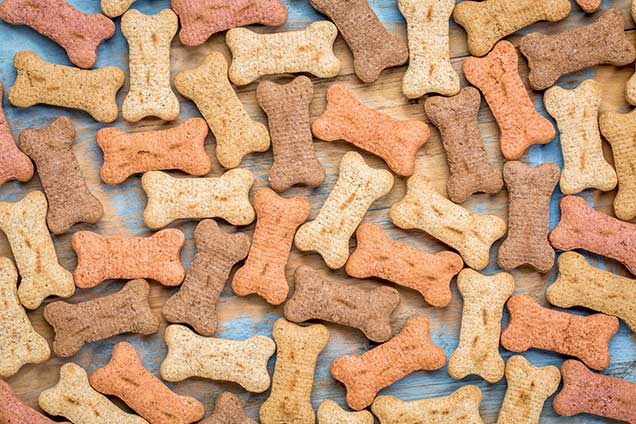Blog Post

Low Calorie Treats for Dogs: Why Every Bite Matters
- By
- •
- 06 Feb, 2018

Pet owners may wonder why their dog remains overweight even after they have cut the dog's meal sizes. Most people do not realize how much dog treats contribute to an obesity problem. Luckily, there are healthier options that can aid the pet in their weight loss efforts. Here is what all dog owners should know about food rewards and calorie counts.
Why It Matters
A small inactive dog needs about 25 calories per pound of body weight per day. A medium-sized dog of about 40 pounds living a moderately active life requires about 960 calories a day. There are numerous charts available online to help factor specifically what each pet requires, but the easiest way to determine what their needs are is to ask their vet.
The reason this matters is that any animal that takes in too many calories will gain weight. Extra weight increases the risk that the pet will develop diseases like cancer, heart disease, and diabetes. It may even exacerbate conditions like dysplasia or arthritis and will usually shorten the life of the animal.
Dogs that are overweight have less stamina, tire easily, and may have a difficult time breathing. The extra weight reduces their quality of life because they cannot go for long walks or take part in the activities they enjoyed when they were thinner.
How Treats Contribute
The average commercial dog treat contains about 20-40 calories and larger chew bone treats include 200 calories or more. Some brands of jumbo chew bones have as many as 700 calories each. If a pet gets two small 30-calorie treats three times a day, it will consume 180 calories or about 20 percent of the daily caloric needs of a medium-sized dog.
Many pet owners give their dog more than one or two treats at a time, and they often include a few leftovers from their own plates as well. A couple of extra nibbles along with the dog's usual treats and the dog can consume as much as half of their daily limit of calories from items that do not provide the nutrients they need to thrive.
What Options Help
There are low-calorie commercial treats, but most homes have affordable options already in their refrigerator and cupboard. Carrots, watermelon, apple, and canned or fresh pumpkin are low calorie, healthy snacks that many dogs love. Other choices include small portions of chicken, hard-boiled eggs, and unsweetened, non-fat yogurt.
Nuts, cheese, and bread are not necessarily bad for dogs, but they are high in calories and fat. It is better to avoid these foods when a pet is dieting and to offer them sparingly once the dog is at an optimum weight. Talk to your vet about additional ideas for a fussy eater.
How to Incorporate
Choose specific times to offer treats rather than just handing them out whenever the pet begs. Treat time could be after a walk, just before bed, or whatever schedule works best for the owner. Purchase treat feeders because they require effort from the pet to get the snack they desire.
Do not provide treats more than twice a day, and be cautious of the portion size. Two ounces or less is a reasonable amount that is equal to a couple of small slices of an apple or a tablespoon of yogurt. When training with treats, cut the food into very small bites so a single serving lasts through the lesson.
It is possible for dogs and their owners to develop healthier habits that can help to extend the life of the pet. If your dog has suddenly developed a little waddle or if you want suggestions for the best diet for your new puppy, schedule an appointment at Hirsch Animal Hospital for assistance.
LOCATION
Hirsch Animal Hospital
220 Valley Circle | Suite 101
Ponte Vedra Beach, FL 32082
Phone:
904-285-0023
Email:
hirschvet@gmail.com
BUSINESS HOURS
Business Hours:
Monday-Friday, 8 a.m.-6 p.m.
Saturday, 8 a.m.-1 p.m.
PAYMENT



LOCATION
Hirsch Animal Hospital
220 Valley Circle | Suite 101
Ponte Vedra Beach, FL 32082
Phone:
904-285-0023
Email:
hirschvet@gmail.com
BUSINESS HOURS
Business Hours:
Monday-Friday, 8 a.m.-6 p.m.
Saturday, 8 a.m.-1 p.m.
PAYMENT



SOCIAL
Share
Tweet
Share
Mail
Content, including images, displayed on this website is protected by copyright laws. Downloading, republication, retransmission or reproduction of content on this website is strictly prohibited. Terms of Use
| Privacy Policy
Content, including images, displayed on this website is protected by copyright laws. Downloading, republication, retransmission or reproduction of content on this website is strictly prohibited. Terms of Use
| Privacy Policy
Content, including images, displayed on this website is protected by copyright laws. Downloading, republication, retransmission or reproduction of content on this website is strictly prohibited. Terms of Use
| Privacy Policy
